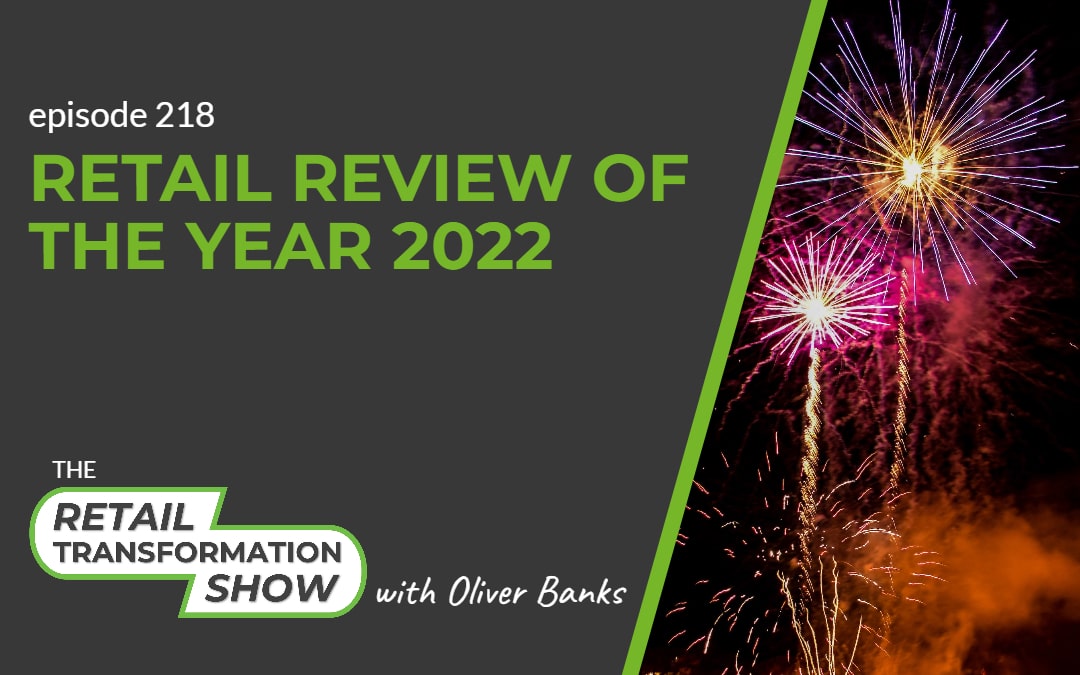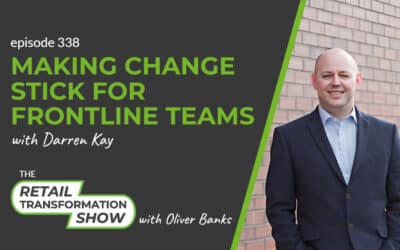2022 has been set against a backdrop of an increasing challenge of rising costs and inflation. And consumers face a cost of living crisis. Never-the-less, the retail market continues to evolve and there have been a number of initiatives this year. From expansive metaverse initiatives through to various tactics to shift the channel mix. 2022 has been tough and eventful in many ways. So join Oliver Banks and reflect on key trends from 2022 and what we can expect going forward.
Listen to this podcast episode to hear:
- Who has pulled out of several major initiatives in 2022 – and is that a good thing?
- Which retailer is taking on perhaps the most audacious fundamental transformation?
- And what 2022 tells us to look out for in 2023.
Remembering the evolving retail market in 2022
2022 has provided plenty of challenges for the retail sector. Following on from a turbulent 2020 and 2021, many started the year optimistically. However, it hasn’t always played out like that. Here are some of the big stories from the past 12 months.
And remember, you can stay in touch with the evolving retail market with the Retail Transformation Briefing. Subscribe to the weekly email newsletter below.
January: JD.com and Ocado are both focused on automation
JD.com looked at expanding into Europe, starting with the Netherlands. Their first automated stores in the continent allow customers to order online for delivery or collection. As soon as the order is placed, the automated store picks and packs the order and prepares for dispatch.
Meanwhile, Ocado were focused on improving productivity in their fulfilment centres. Their primary innovation that was announced in January 2022 was a robotic picking arm to focus in on further automation and improved efficiency for their current robotic devices. They have also experiemented with 3D printed robots and software improvements too.
And this theme of automation has been one that many large retailers like Walmart, Tesco, Target and others have focused on this year.
February: The start of the Ukraine war
This conflict drew massive attention as it escalated quickly. Many retailers acted quickly – either by pulling out of the country or by changing their supply chain. And of course, this has provided additional challenges through the year too through fuel, oil, raw materials, and energy.
Like the Covid-19 pandemic, this highlighted the global, highly interconnected supply chain that is deeply embedded in today’s retail industry. As such, many have continued to focus on building resilience, agility and reverting to local sourcing strategies.
Given the challenging market that exists in 2022 and will extend into 2023, there are opportunities to squeeze out improved performance on multiple fronts. For additional listening, try episode 210: Making Marginal Gains To Drive Profit to learn more,
March: The first metaverse Fashion Week
Selfridges, D&G and Tommy Hilfiger were among the brands featured in the first metaverse based Fashion Week. And we’ve seen more metaverse plays this year. Most commonly, these have featured on Roblox’s platform.
But as the concept of the metaverse continues to evolve and emerge, we continue to see brands experimenting. The purpose of a metaverse store or location is key. What’s the point of having it? And why should customers care? Perhaps it is around expanding into a digital clothing proposition, or trying to evolve brand reputation and experience.
However, as Oliver points out in the episode, there are not many companies or initiatives that are focused on the community side of the metaverse at present.
Discover more about the metaverse in episode 172: Exploring What The Metaverse Means.
April: Meta announce their first physical retail store
With the aim of encouraging more consumers to explore the metaverse, Meta announced that they were planning a physical store estate. For the metaverse to become a meaningful channel, it will need to expand to the mass market. Meta recognises this. They also recognise that it can be daunting and complicated to work out how. So they’re looking to physical retail where consumers can see the equipment, try things out, ask questions and get advice for their digital exploration.
The underlying theme is to focus on omnichannel. And appealing to customers in the best channel based on what people are trying to achieve.
May: Zara charges for online returns
Returns have been a headache for ecommerce retailers for years. And in May, Zara were one of the first names to make a pivot in their online strategy and started charging customers for making returns. And since, more retailers have also followed suit, including boohoo and Next.
71% of UK consumers would avoid online shopping if they have to pay for returns.
Appinio via Charged Retail.
It’s an interesting challenge – should you charge for returns, knowing that more customers will be put off from purchasing? There are interesting debates for both sides. And as Oliver explains in the podcast, we may start to see more “returns insurance” propositions to balance the costs and hassle of returns with the opportunity to win new customers and sales.
In episode 149: The Retail Returns Conundrum, Oliver explores more about the returns challenge.
June: John Lewis begins their transformation to move into building and renting homes
Department store, John Lewis, have been retailing for over 150 years. However, they are plotting a fundamental transformation as they start to move into the residential property market. In June, they announced that they had found their first 3 locations. And they’ve also since announced a partnership with a construction company.
It will be interesting how the company continues to evolve. Will this new direction distract the company? Or will it offer a more profitable arm – like how Amazon has AWS.
July: Building digital capabilities and results
Nike attributed the 18% growth of their digital business down to their consumer apps. This shows the opportunity of useful apps – such as their training, wellness, sneaker or retail apps. These different apps help consumers to achieve what’s important for them. And as such, they elevate the Nike brand to be more supportive rather than “just a retail brand.”
Smartphones are now part of everyday life – and have been for some time now. So it’s important to consider how you want your customers to use a smartphone when shopping with you. Listen to episode 206: Evolving In Store Experiences With Smartphones with Chargebox MD, Ian Hobson.
Also in July, more retailers announced initiatives to discover and hone their digital and data capabilities. Decathlon opened a “Data Lab” to aid collaboration and to act as an incubator for their fledgling digital and data-based innovations. Meanwhile, Asos extended their Data Academy to help train and develop data science and analytics skills with 3 different programmes to choose from. Finally, Boohoo ran a data boot camp to enhance skills for teenagers as part of their community strategy.
To learn more about data science in retail, check out episode 120: Understanding Data and Data Science In Retail featuring Ian Shepherd.
August: Are Amazon stumbling?
Amazon paused the UK expansion of their checkout-free stores. They cancelled a number of sites in the face of reduced sales compared to expectation. However, they have kept their existing “Fresh” stores open and are continuing to trade.
This feels like the classic “test and learn” approach in action. The initial stores have provided a testing ground. And now they are in a learning phase to assess and decide how to evolve.
Also, Amazon pulled out of Amazon Care healthcare offering. This is their virtual service to connect patients with doctors and nurses virtually. However, also this year, Amazon announced the closure of all of their physical bookshops and “4 Star” stores in the UK and US to focus on their fashion, department store and grocery concepts.
Also in 2022, Amazon have announced a peak surcharge for suppliers using the FBA (Fulfilled by Amazon) service. Prices were increased for their Prime subscription service. They’ve had to deal with a number of industrial actions and strikes at distribution centres.
Plus, they’ve stopped experimenting with their Scout robot deliveries and are significantly scaling back some of their tech teams, including in their Alexa division. The latter formed the largest labour reduction in the company’s history.
All of these factors which suggest the ecommerce giant are stumbling. However, Oliver thinks there will be some strong learnings which help turn the company’s fortunes around.
September: Selfridges announced sales targets for sustainable business models
Iconic department store, Selfridges, announced they are targeting half of their transactions to be either resale, repair, rental or refills by 2030. These new business model initiatives offer great opportunity. However, they also need new operating models as there are significant differences compared to the classic ways of working.
In addition, many other retailers have announced resale platforms or marketplaces this year. These show the growth in consumer demand and also suggests future opportunity too as consumers will increasingly expect resale options. Both for buying and selling.
Also this year, another sustainability headline was when Tesco announced that executive bonuses would be linked to sustainability metrics and performance.
Try listening to episode 181: 6 New Business Models Driven By Sustainability to dive deeper.
October: Walmart want influential content creators to generate new sales
Walmart announced their “Creator” platform. They are looking for micro influencers to create content to drive sales. In return, these creators earn a commission on sales they help generate.
To further develop this, Walmart also announced a deal with shoppable video platform, Firework, this year. You might enjoy episode episode 202: Immersive Video To Engage Customers which features Firework’s Jason Holland.
Also this year, Amazon have also announced similar opportunities and platforms for individual influencers to earn commission and affiliate fees.
November: Primark finally start their ecommerce journey
Discount fashion retailer, Primark, have resisted the urge to move into ecommerce for a long time. Throughout the pandemic, their stores remained closed and there was no way for customers to make a purchase. However, in November, Primark finally launched their click and collect offering.
This is a great example to remind us that it’s never too late to change or transform.
December: Acquisitions suggest the ‘Great Retail Consolidation’
We saw a flurry of retail acquisitions as the year drew to a close. For a long time, many have suggested that the market has been “over-retailed”. And the ferocious competition has added choice and flexibility for customers. Customers have been spoilt when it comes to choice. And ultimately, this has resulted in reduced customer loyalty.
But acquiring a company is a challenge, especially when it comes to integration and future growth. Listen to episode 215: Making Acquisitions Successful for a review of some of the major deals announced as 2022 came to a close. Plus Oliver shares how you can plan and deliver a successful acquisition and integration.
What was your favourite transformation story?
Reach out to Oliver Banks on email to share your favourite headlines. Email him on oliver.banks@obandco.uk or reach out to Oliver Banks on LinkedIn.
Additional episodes to listen to now
There are a number of suggested episodes in the above review of 2022. There are however always more episodes to continue to learn. In particular, listen to episode 200: The Ever-Trends Of Retail. These 8 themes are always relevant and often underpin many of the headlines and evolutions over time.
Listen to episode 216: What To Learn From The Disruption Of 2022 as Oliver reflects on some of the challenges presented over the past 12 months.
In the face of challenges with the quick commerce market and checkout-free stores, Oliver asks if there is a pattern to be concerned with. Listen to episode 207: Is Retail Transformation Failing At Present? to find out more.


















![337: [Show Update] Pressing Pause to Refocus](https://obandco.uk/wp-content/uploads/2025/07/337-Show-Update-Pressing-Pause-to-Refocus-1080x675px-400x250.jpeg)